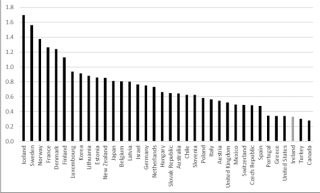How are Ireland's children doing?

Children are one of the most vulnerable groups in any society. The care and support we provide for them will play a large part in determining the adults they will become. The 2023 report from the Department of Children, Equality, Disability, Integration and Youth, 'State Of The Nation’s Children', gathers key information on children’s health in Ireland, their "behavioural and educational outcomes" and also looks at their key relationships with parents and friends.
Some Key Findings
In 2023, it is estimated that children accounted for 23.2 per cent of the overall population (1,255,738 children).
In 2022, there were 131,764 children with a disability in Ireland. This accounted for 10.8 per cent of the child population.
In 2022, there were 14,142 Traveller children in Ireland. This accounted for just 1.2 per cent of the total child population but comprises 42.9 per cent of the total Traveller population.
In 2022, 15.5 per cent of children lived in a single parent family unit.
In 2018, 83.3 per cent of children aged between 10 and 17 reported finding it easy to talk to their mother when something is really bothering them and 67.9 said that about their father.
In 2018, 31.1 per cent of children aged between 10 and 17 reported having been bullied at school in the past couple of months. This figure was an increase on 2014.
For the 2022/23 pre-school year there were 108,616 children registered for the latest finalised Early Childhood Care and Education (ECCE) programme call under Core Funding.
The Leaving Certificate retention rate for children entering secondary school in 2016 was 91.7 per cent.
In 2018, 88.2 per cent of children aged between 10 and 17 reported being happy with their lives at present. This decreased between 2014 and 2018.
Public expenditure on educational institutions between primary and tertiary level decreased as a percentage of gross domestic product (GDP) from 5.21 per cent in 2013 to 3.13 per cent in 2019 although in monies spent, increased from €8,286,000,000 in 2013 to €9,192,000,000 in 2018.
In 2022, 15.2 per of children were considered to be at risk of poverty, down from 15.9 per cent in 2018 and 7.5 per cent of children experienced consistent poverty, down from 7.7 per cent in 2018.
Delivering on the commitment "to make Ireland the best country in Europe to be a child"
Poverty and Income
The latest EU Survey on Income and Living Conditions (SILC) data indicates that over 188,600 children were living in poverty in 2022. Almost 250,000 children, were experiencing enforced deprivation, going without basic necessities due to a lack of adequate income. However, child poverty does not exist in a vacuum. Children live in families, households, and societies. They are impacted by the physical environment in which they live. The damage done by poverty to children's wellbeing and outcomes can last a lifetime. A CSO report published in December 2020 examined the Intergenerational Transmission of Disadvantages using data from a module included in the SILC 2019 survey. Based on answers from people aged 25-59 about their life situation when they were about 14 years old, the report explored if a person’s household circumstances as a teenager are associated with poverty indicators in later life. Among its findings, the report highlighted the intergenerational impacts of lower completed education levels as respondents whose parents had lower secondary education had a 16.2 per cent risk of poverty as adults compared with 6.2 per cent for those who had parents with third level education. The CSO report also found that financial disadvantage in childhood appears to persist to adulthood. People who described the financial situation of their teenage home as bad were most likely to be at risk of poverty (18.2 per cent) or living in enforced deprivation (39 per cent) as adults in 2019.
According to the MESL Annual Update 2023, the cost of a child’s core minimum essential standard of living fluctuates with age, ranging from €59 per week for a pre-school child to €156 for a child in second-level education. The increased cost of living since October 2021 has put pressure on all households, but particularly families with children. The MESL Research Centre estimate that the cost of the food budget of households with children increased by approximately 23 per cent between 2022 and 2023, the largest increase of any household type, while two parent families living in urban areas experienced an average increase on weekly energy costs of 72 per cent. Child benefit remains a key route to tackling child poverty and is of particular value to those families on the lowest incomes. It is the only payment specifically for the child and is protected income for the purpose of calculating reasonable living expenses on insolvency. As a universal payment, it also safeguards against ‘welfare traps’ which can inhibit labour force participation of welfare dependent households who cannot afford to forego child payments which are linked to their core welfare payments. In order to support households with children, all core social welfare payments must increase to take account of inflation.
Policy Priorities must be to set an ambitious poverty-reduction target and commit sufficient resources to achieving it, increase core social welfare payments and Child Benefit.
Education
Access to appropriate education and skills development from early years to adulthood is one of the key public services that enables participation in society, public life and the labour market. The gap between the performance of students in disadvantaged areas and their peers is evident in results on education and cognitive development. The Growing up in Ireland survey found significant differences in reading test scores by socio-economic background and that this socio-economic gap in reading test scores widened in primary school, with children from disadvantaged backgrounds who were early high performers being outperformed by children from more advantaged backgrounds by 9 years of age.[1]
Previous Action Plans for Education focused on the need to address the disparity between DEIS bands by increasing literacy and numeracy levels in DEIS Band 1 schools with a target improvement rate of between 27 and 42 per cent by 2020. The final evaluation of the Action Plan for Education is not available, but this target did not demonstrate sufficient ambition to really effect change. A Consultation is currently underway on a new literacy and numeracy strategy for young people. It is important that ambitious targets, with a particular focus on DEIS schools are included. Ireland currently has a pupil teacher ratio at primary level of 15.0 (the EU average is 13.6) (Chart 3.1) and an average class size of 25 (the EU average is 20). The policy focus must be on keeping average class sizes low, reducing the pupil/teacher ratio further and ensuring all DEIS Band 1 and 2 schools have sufficient resources to implement strategies to improve literacy and numeracy outcomes for pupils.
Early Childhood Care
One of the key challenges identified towards the provision of universal early childcare in Ireland is the market driven approach to provision at present. As shown in Chart 1, public expenditure on early childcare in Ireland compared to other OECD countries was very low.
Chart 1: Public expenditure on early childhood education and care, as a % of GDP, 2019

High staff turnover and poor pay and conditions are also a feature of the sector. A review of Early Years Education published by the Department of Education and Skills found that while almost all services provide warm and welcoming environments and strong evidence of positive relations was found between the staff, the children and their families, there remained many challenges including the need to improve working conditions for staff in the sector.[2]
Policy Priorities must commit to reducing class sizes and pupil teacher ratios at primary and post primary level by 1 point per annum to 2030 and to make the improvement of educational outcomes for pupils from disadvantaged backgrounds and disadvantaged communities a policy priority. We must also commit to increasing investment in Early Childhood Care and Education by 0.1 per cent of GNI* annually.
[1] Government of Ireland (2021) Growing up in Ireland: The lives of nine years olds of Cohort ’08. Report 10
[2] Department of Education and Skills (2018) Ireland’s National Skills Strategy 2025. Dublin: Stationery Office.